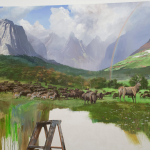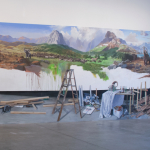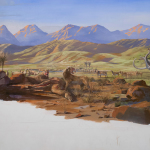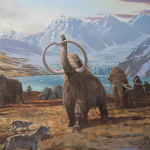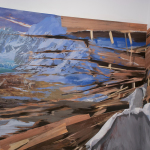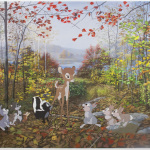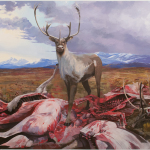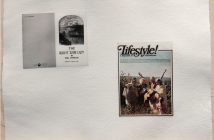Adam Cvijanovic’s paintings do just that. They expose the elaborate artifice behind what we call "Nature" and yet they do not adopt a simple, "nothing-is-natural" stance. The paintings suggest that nature may actually in fact exist but that humanity’s access to it is filtered always by historical, perceptual, and cultural modes of understanding. Whether through advanced communications media or the seemingly isolated movement of a painting brush, anytime we reference or depict "nature," we are circling it, containing it, trying to capture it with our net of compulsive human misunderstanding.
Crashing into the pristine nature of Discovery of America’s Pleistocene landscape is a scene of men dashing through the plains on horses, based on a photograph of the Oklahoma Land Rush in 1889. Rendered in black-and-white, the cowboys appear to be riding through an old Hollywood Western film, and they cause the canvas to shred and tear, smashing its frame into smithereens. The destroyed continuity of the painting suggests the inability to depict what exactly happened when humanity arrived in North America, or when European settlers pushed aside indigenous inhabitants—as if there were a chronological or geographical gap, a historical blindspot, or perhaps a trauma so profound it defies representation. How do we imagine what life on earth was like before the destruction wrought by our species? Or what North America was like before the arrival of European colonists and settlers? The painting’s wooden structure spills out onto the studio floor, where the artist has left quite a few empty bottles of beer. The painting shows that this rupture is momentous, cinematic, but also mundane, the aftermath of which we are all living in today, in a human-dominated planet earth. What more can we do than go have a drink?
In Osborne Caribou (2012), a caribou stands tall and proud atop a pile of bloody, skinned carcasses. That the caribou on the ground are gutted with the clean lines of a knife indicates the work of hungers, suggesting yet another way in which humans relate to the natural world, as food to be eaten. The standing caribou looks hyperreal; the outline of his body is too vivid and smooth, as if Cvijanovic were adopting a Photoshop aesthetic in his painting. I half-expected the caribou to suddenly move, and I wonder if, even as a backpacker and an outdoorsperson, my encounters with animals have become so dominated by media representations that I actually expect animals to act like animations.
Cvijanovic titled his 2012 Postmasters show "Natural History," but his natural landscapes and diorama-type paintings are not simple riffs on the American Museum of Natural History; his work initiates an artistic meditation on the labor and subjectivity behind what we call science and nature, behind the supposed objectivity of the museum. Nature is not a perfect origin or an untouched state in Cvijanovic’s work. It loses that aura of timelessness. Instead, the viewer becomes aware of nature as an elusive quality that is always in a state of becoming and unbecoming, subject to whims, to moods, to the media we have consumed or the beers we have imbibed. Does Discovery of America really depict what the Late Pleistocene Era looked like? Does the Museum of Natural History do any better? Or are our understandings of natural history the construction of a random painter who just ate too much pizza and, exasperated with the limitations of his work, just left the building to take a break?
- Adam Cvijanovic Discovery of America (detail), 2012 Flash acrylic on Tyvek 15 x 65 feet Image courtesy of Postmasters Gallery
- Addam Cvijanovic Discovery of America (installation detail ), 2012 Flash acrylic on Tyvek 15 x 65 feet Image courtesy of Postmasters Gallery
- Adam Cvijanovic Discovery of America (detail), 2012 Flash acrylic on Tyvek 15 x 65 feet Image courtesy of Postmasters Gallery
- Adam Cvijanovic Discovery of America (detail), 2012 Flash acrylic on Tyvek 15 x 65 feet Image courtesy of Postmasters Gallery
- Adam Cvijanovic Discovery of America (detail), 2012 Flash acrylic on Tyvek 15 x 65 feet Image courtesy of Postmasters Gallery
- Adam Cvijanovic White Tailed Deer, 2012 Flash acrylic on Tyvek 99 x 144 inches (8.25 x 12 ft) Image courtesy of Postmasters Gallery
- Adam Cvijanovic Osborne Caribou, 2012 Flash acrylic on Tyvek 99 x 144 inches (8.25 x 12 ft) Image courtesy of Postmasters Gallery
Icon image:
Adam Cvijanovic
Discovery of America (detail), 2012
Flash acrylic on Tyvek
15 x 65 feet
Image courtesy of Postmasters Gallery




